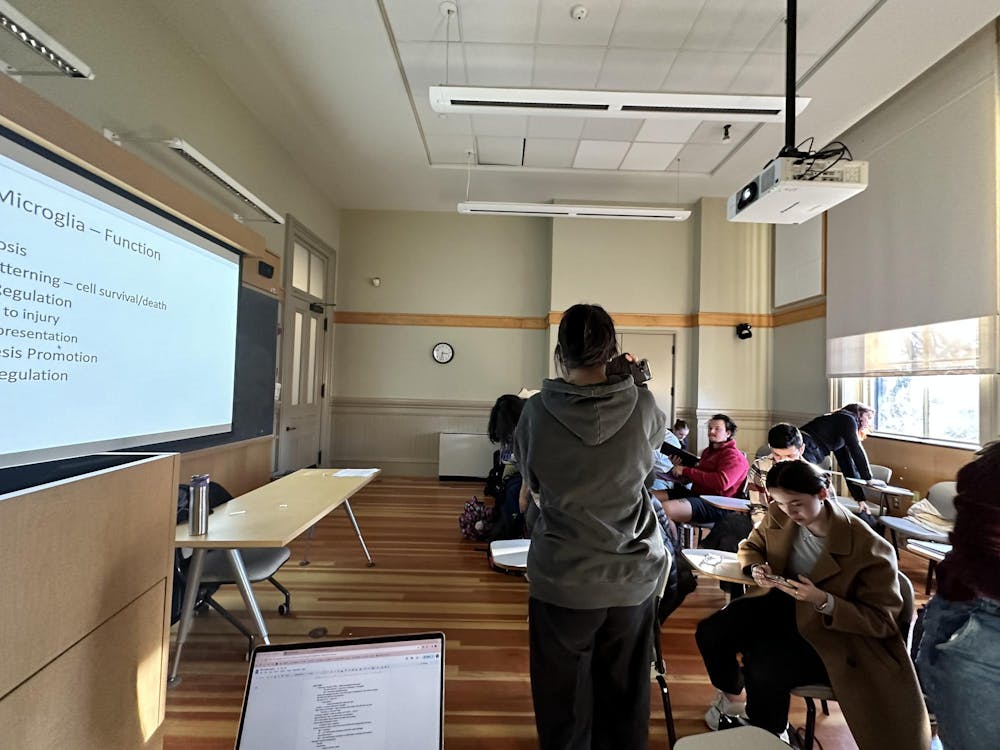Throughout history, people have grappled with imagining and defining “invisible” objects — from microscopic organisms to the cosmos and our galaxy. Two new courses, STS 1700F: “Visualizing the Invisible: Art, Science and Observation” and NEUR 1570: “The Non-Neural Brain” hope to help students “see” the invisible.
In STS 1700F: “Visualizing the Invisible: Art, Science and Observation,” offered for the first time this semester, students will explore historical methods of observation and develop their own techniques for visualizing the invisible world.
The class uses both art and science to understand and communicate objects that are “hard to see with the naked eye,” according to Elaine Ayers, visiting assistant professor of science, technology and society. The seminar class has 18 students currently enrolled, according to Courses@Brown.
STS 1700F centers on developing a philosophical definition for observation in order to explore the multiple venues through which humans comprehend the world, rather than solely focusing on vision.
“I've taught other versions of this class (at different universities) in the past, but I really was excited to bring it to Brown because of our connection with RISD,” Ayers said. “Brown has this fantastic opportunity (for artistic investigation), sitting a couple blocks away.”
The opportunity for hands-on experience using different artistic means of visualization caught the attention of Jennifer Tran ’25, a student taking the class. “We’re going to the RISD Nature Lab and doing a glass blowing workshop at RISD, and that’s something I've never done before,” Tran said.
Open to all students regardless of artistic or scientific background, the course aims to introduce students to new skills that they otherwise wouldn’t be exposed to. “I think that trying new things and experimenting with them makes you a stronger student and stronger person overall,” Ayers said.
The class’ syllabus includes drawing microscopic illustrations of sea urchins and using AI to generate visualizations of climate change.
Tran highlighted the importance of being conscious of race and gender in discussions about science. The class readings include themes of repatriation of minorities, popular Darwinism through the lens of photography and the relationship between white supremacy and violence. This has led Tran to consider how scientists treat and view bodies used in their experiments.
Ultimately, Ayers endeavors to “lower an intimidation bar” for students who may be apprehensive when faced with the artistic or scientific component of the course. “I hope that we start to think very interdisciplinarily and stop thinking about the arts and sciences as different fields of study,” Ayers says.
Another new course, NEUR 1570: “The Non-Neural Brain,” explores a different “invisible” object: glial cells.
According to Assistant Professor of Brain Science Dr. Sonia Mayoral, the class centers around these lesser-known cells “that make up more than half of the cells in your brain” and hold potential for a wide variety of brain function research.
Over the summer, Dr. Mayoral worked with Natalie Chernysh ’24, a neuroscience concentrator, to develop the course. “We took a backwards design approach,” Chernysh said.
By focusing first on the key objectives and using them to develop the course structure, Chernysh hopes to “take an application lens to understand the importance of glia for developing therapies and strategies for repairing and improving brain function.”
Chernysh now works as the teaching assistant for the course, which meets twice a week. Students also meet outside of class to participate in projects centered around scientific communication and translation. One of these projects, Brain Day, takes place at Brown’s Engineering Research Center every March, where students will have the opportunity to teach neuroscience to young kids and the Providence community.
“We hope to not only convey basic scientific understanding to audiences, but also challenge our students to apply the knowledge they gain from the class and really think beyond what currently exists in the research and the literature,” Chernysh said.
The potential of glial cells in aiding disease and therapy treatments excites Mayoral. “I think glia will make a big impact on neuroscience research,” Mayoral said. “They have been and continue to be highly understudied, so there’s still a lot to learn about them and their roles in brain function.”





